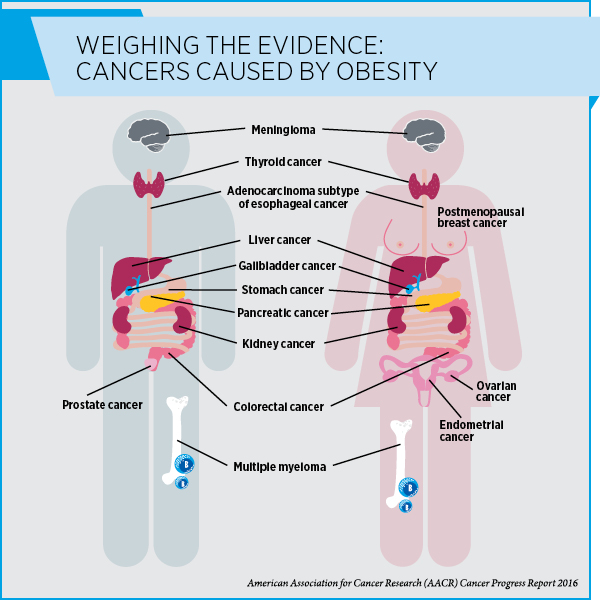One More Reason to Stay Trim: Reduce Your Liver Cancer Risk
Liver cancer rates have been on the rise in the United States and have tripled in the last four decades. A study published in 2014 in the AACR’s journal Cancer Research projected that pancreatic cancer and liver cancer will surpass breast, prostate, and colorectal cancers to become the second and third leading causes of cancer death, following lung cancer.
This year, 39,230 new cases of liver and intrahepatic bile duct cancer are expected to be diagnosed in the United States and about 27,170 people are expected to die of primary adult liver cancer, according to the National Cancer Institute.
Besides liver cancer, two other conditions have been experiencing an increasing trend since the mid-1970s: obesity and type 2 diabetes mellitus.
Last week, a study published in Cancer Research found that these three disorders are linked: In a large prospective cohort study, two factors of obesity, high body mass index (BMI) and increased waist circumference, and an obesity-related disease, type 2 diabetes mellitus, were associated with increased risk for liver cancer.
“Liver cancer rates have approximately tripled in the United States since the mid-1970s and the prognosis for patients diagnosed with this type of cancer is especially grim,” says study lead author Peter Campbell, PhD, strategic director of Digestive System Cancer Research at the American Cancer Society.
The five-year survival rate for people with localized liver cancer is 30.9 percent, and for those with advanced disease, it is a dismal 3.1 percent.
Given that the rates of obesity and diabetes are increasing in the United States, Campbell and colleagues pooled data from 1.57 million adults enrolled in 14 different U.S.-based prospective studies and examined whether obesity, as measured by BMI and waist circumference, and type 2 diabetes mellitus are associated with liver cancer risk in a combined sample of U.S. adults from 14 different studies.
Here’s what they found:
- For every 5 kg/m2 increase in BMI, there was a 38 and 25 percent increase in the risk for liver cancer in men and women, respectively.
- For every 5 cm increase in waist circumference, there was an 8 percent increase in the risk for liver cancer.
- When adjusted for alcohol intake, smoking, race, and BMI, participants with type 2 diabetes mellitus were 2.61 times more likely to be diagnosed with liver cancer, and the risk increased with increase in BMI.
“This adds substantial support to liver cancer being on the list of obesity-associated cancers,” says Campbell. The findings also add further evidence to support public health efforts aimed at curbing obesity, he notes.
“From a public health perspective, these results are very important because obesity and diabetes, unfortunately, are common conditions in the population,” says senior author of the study Katherine A. McGlynn, PhD, MPH, a senior investigator in the Metabolic Epidemiology Branch at the National Cancer Institute. “While some other well-described risk factors, such as hepatitis B virus or hepatitis C virus, are associated with increased risks of liver cancer, these factors are much less common than are obesity and diabetes.”
Obesity – the root cause of many health problems
As noted in the AACR Cancer Progress Report 2016, in addition to liver cancer, being overweight or obese increases a person’s risk for developing 13 other types of cancer: the adenocarcinoma subtype of esophageal cancer, advanced prostate cancer, meningioma, multiple myeloma, and colorectal, endometrial, gallbladder, kidney, ovarian, pancreatic, stomach, thyroid, and postmenopausal breast cancers.

As stated by the National Institutes of Health, besides increasing the risk for several cancers, obesity also increases the risk for type 2 diabetes, heart diseases, high blood pressure, and stroke. The report also states that in the United States, about 70 percent of adults 20 years or older and more than 30 percent of youth ages 2 to 19 are overweight or obese.
Campbell notes that their data associating liver cancer with obesity “is yet another reason to maintain a body weight in the ‘normal’ range for your height.” He adds that the findings are also consistent with other data indicating that obesity and diabetes might be playing a role in the rapid increase in liver cancer in recent decades.
“Liver cancer isn’t simply related to excess alcohol intake and viral hepatitis infection,” he says.
This study was covered by many news outlets, including The New York Times and CBS News.






Is smoking reason for liver cancer.
The risk factors for liver cancer include chronic infection with hepatitis B or hepatitis C virus, cirrhosis, alcohol, obesity, gender, race/ethnicity, type 2 diabetes, and smoking.